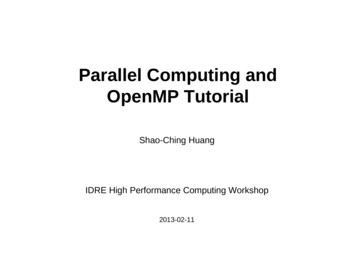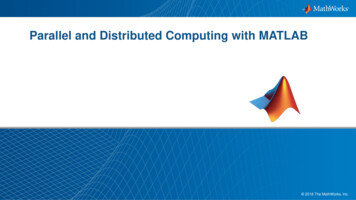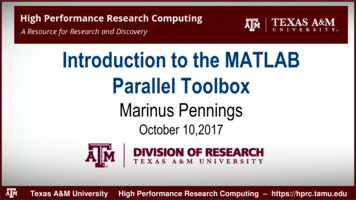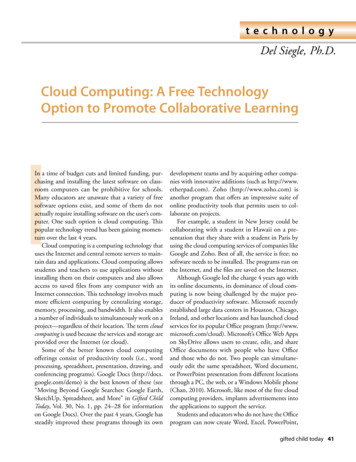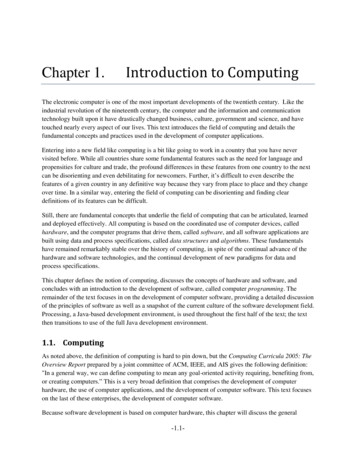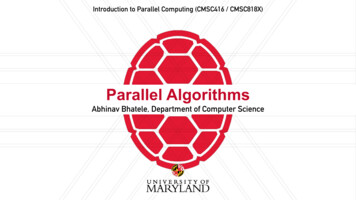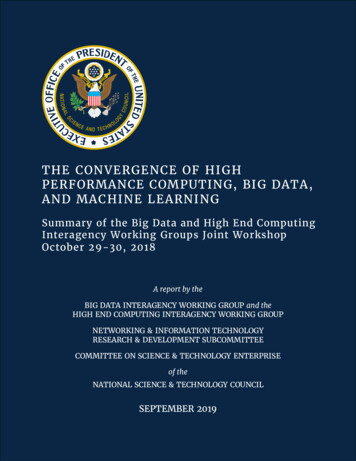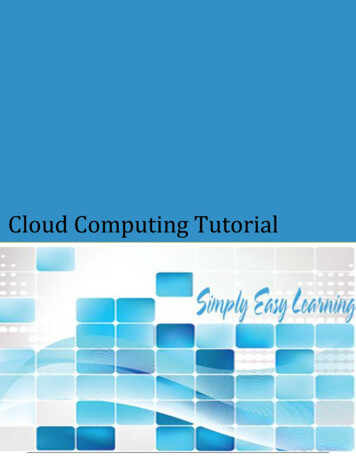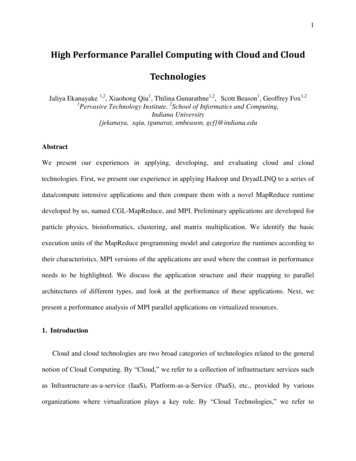
Transcription
1High Performance Parallel Computing with Cloud and CloudTechnologiesJaliya Ekanayake 1,2, Xiaohong Qiu1, Thilina Gunarathne1,2, Scott Beason1, Geoffrey Fox1,21Pervasive Technology Institute, 2School of Informatics and Computing,Indiana University{jekanaya, xqiu, tgunarat, smbeason, gcf}@indiana.eduAbstractWe present our experiences in applying, developing, and evaluating cloud and cloudtechnologies. First, we present our experience in applying Hadoop and DryadLINQ to a series ofdata/compute intensive applications and then compare them with a novel MapReduce runtimedeveloped by us, named CGL-MapReduce, and MPI. Preliminary applications are developed forparticle physics, bioinformatics, clustering, and matrix multiplication. We identify the basicexecution units of the MapReduce programming model and categorize the runtimes according totheir characteristics. MPI versions of the applications are used where the contrast in performanceneeds to be highlighted. We discuss the application structure and their mapping to parallelarchitectures of different types, and look at the performance of these applications. Next, wepresent a performance analysis of MPI parallel applications on virtualized resources.1. IntroductionCloud and cloud technologies are two broad categories of technologies related to the generalnotion of Cloud Computing. By “Cloud,” we refer to a collection of infrastructure services suchas Infrastructure-as-a-service (IaaS), Platform-as-a-Service (PaaS), etc., provided by variousorganizations where virtualization plays a key role. By “Cloud Technologies,” we refer to
2various cloud runtimes such as Hadoop(ASF, core, 2009), Dryad (Isard, Budiu et al. 2007), andother MapReduce(Dean and Ghemawat 2008) frameworks, and also the storage andcommunication frameworks such as Hadoop Distributed File System (HDFS), AmazonS3(Amazon 2009), etc.The introduction of commercial cloud infrastructure services such as Amazon EC2,GoGrid(ServePath 2009), and ElasticHosts(ElasticHosts 2009) has allowed users to provisioncompute clusters fairly easily and quickly, by paying a monetary value for the duration of theirusages of the resources. The provisioning of resources happens in minutes, as opposed to thehours and days required in the case of traditional queue-based job scheduling systems. Inaddition, the use of such virtualized resources allows the user to completely customize theVirtual Machine (VM) images and use them with root/administrative privileges, another featurethat is hard to achieve with traditional infrastructures. The availability of open source cloudinfrastructure software such as Nimbus(Keahey, Foster et al. 2005) and Eucalyptus(Nurmi,Wolski et al. 2009), and the open source virtualization software stacks such as XenHypervisor(Barham, Dragovic et al. 2003), allows organizations to build private clouds toimprove the resource utilization of the available computation facilities. The possibility ofdynamically provisioning additional resources by leasing from commercial cloud infrastructuresmakes the use of private clouds more promising.Among the many applications which benefit from cloud and cloud technologies, thedata/compute intensive applications are the most important. The deluge of data and the highlycompute intensive applications found in many domains such as particle physics, biology,chemistry, finance, and information retrieval, mandate the use of large computing infrastructuresand parallel processing to achieve considerable performance gains in analyzing data. The
3addition of cloud technologies creates new trends in performing parallel computing. Anemployee in a publishing company who needs to convert a document collection, terabytes insize, to a different format can do so by implementing a MapReduce computation using Hadoop,and running it on leased resources from Amazon EC2 in just few hours. A scientist who needs toprocess a collection of gene sequences using CAP3(Huang and Madan 1999) software can usevirtualized resources leased from the university’s private cloud infrastructure and Hadoop. Inthese use cases, the amount of coding that the publishing agent and the scientist need to performis minimal (as each user simply needs to implement a map function), and the MapReduceinfrastructure handles many aspects of the parallelism.Although the above examples are successful use cases for applying cloud and cloudtechnologies for parallel applications, through our research, we have found that there arelimitations in using current cloud technologies for parallel applications that require complexcommunication patterns or require faster communication mechanisms. For example, Hadoop andDryad implementations of Kmeans clustering applications which perform an iteratively refiningclustering operation, show higher overheads compared to implementations of MPI or CGLMapReduce (Ekanayake, Pallickara et al. 2008) – a streaming-based MapReduce runtimedeveloped by us. These observations raise questions: What applications are best handled bycloud technologies? What overheads do they introduce? Are there any alternative approaches?Can we use traditional parallel runtimes such as MPI in cloud? If so, what overheads does ithave? These are some of the questions we try to answer through our research.In section 1, we give a brief introduction of the cloud technologies, and in section 2, wediscuss with examples the basic functionality supported by these cloud runtimes. Section 3discusses how these technologies map into programming models. We describe the applications
4used to evaluate and test technologies in section 4. The performance results are in section 5. Insection 6, we present details of an analysis we have performed to understand the performanceimplications of virtualized resources for parallel MPI applications. Note that we use MPI runningon non virtual machines in section 5 for comparison with cloud technologies. We present ourconclusions in section 7.2. Cloud TechnologiesThe cloud technologies such as MapReduce and Dryad have created new trends in parallelprogramming. The support for handling large data sets, the concept of moving computation todata, and the better quality of services provided by the cloud technologies make them favorablechoice of technologies to solve large scale data/compute intensive problems.The granularity of the parallel tasks in these programming models lies in between the finegrained parallel tasks that are used in message passing infrastructures such as PVM(Dongarra,Geist et al. 1993) and MPI(Forum n.d.) ; and the coarse grained jobs in workflow frameworkssuch as Kepler(Ludscher, Altintas et al. 2006) and Taverna(Hull, Wolstencroft et al. 2006), inwhich the individual tasks could themselves be parallel applications written in MPI. Unlike thevarious communication constructs available in MPI which can be used to create a wide variety ofcommunication topologies for parallel programs, in MapReduce, the “map- reduce” is the onlycommunication construct available. However, our experience shows that most composableapplications can easily be implemented using the MapReduce programming model. Dryadsupports parallel applications that resemble Directed Acyclic Graphs (DAGs) in which thevertices represent computation units, and the edges represent communication channels betweendifferent computation units.In traditional approaches, once parallel applications are developed, they are executed on
5compute clusters, super computers, or Grid infrastructures (Foster 2001), where the focus onallocating resources is heavily biased by the availability of computational power. The applicationand the data both need to be moved to the available computational resource in order for them tobe executed. These infrastructures are highly efficient in performing compute intensive parallelapplications. However, when the volumes of data accessed by an application increases, theoverall efficiency decreases due to the inevitable data movement. Cloud technologies such asGoogle MapReduce, Google File System (GFS) (Ghemawat, Gobioff et al. 2003), Hadoop andHadoop Distributed File System (HDFS), Microsoft Dryad, and CGL-MapReduce adopt a moredata-centered approach to parallel runtimes. In these frameworks, the data is staged indata/compute nodes of clusters or large-scale data centers, such as in the case of Google. Thecomputations move to the data in order to perform the data processing. Distributed file systemssuch as GFS and HDFS allow Google MapReduce and Hadoop to access data via distributedstorage systems built on heterogeneous compute nodes, while Dryad and CGL-MapReducesupport reading data from local disks. The simplicity in the programming model enables bettersupport for quality of services such as fault tolerance and monitoring.2.1 HadoopApache Hadoop has a similar architecture to Google’s MapReduce runtime, where itaccesses data via HDFS, which maps all the local disks of the compute nodes to a single filesystem hierarchy, allowing the data to be dispersed across all the data/computing nodes. HDFSalso replicates the data on multiple nodes so that failures of any nodes containing a portion of thedata will not affect the computations which use that data. Hadoop schedules the MapReducecomputation tasks depending on the data locality, improving the overall I/O bandwidth. Theoutputs of the map tasks are first stored in local disks until later, when the reduce tasks access
6them (pull) via HTTP connections. Although this approach simplifies the fault handlingmechanism in Hadoop, it adds a significant communication overhead to the intermediate datatransfers, especially for applications that produce small intermediate results frequently.2.2 Dryad and DryadLINQDryad is a distributed execution engine for coarse grain data parallel applications. Itcombines the MapReduce programming style with dataflow graphs to solve the computationtasks. Dryad considers computation tasks as directed acyclic graph (DAG)s where the verticesrepresent computation tasks and with the edges acting as communication channels over whichthe data flow from one vertex to another. The data is stored in (or partitioned to) local disks viathe Windows shared directories and meta-data files and Dryad schedules the execution ofvertices depending on the data locality. (Note: The academic release of Dryad only exposes theDryadLINQ (Y.Yu, Isard et al. 2008) API for programmers. Therefore, all our implementationsare written using DryadLINQ although it uses Dryad as the underlying runtime). Dryad alsostores the output of vertices in local disks, and the other vertices which depend on these results,access them via the shared directories. This enables Dryad to re-execute failed vertices, a stepwhich improves the fault tolerance in the programming model.2.3 CGL-MapReduceCGL-MapReduce is a light-weight MapReduce runtime that incorporates severalimprovements to the MapReduce programming model such as (i) faster intermediate datatransfer via a pub/sub broker network; (ii) support for long running map/reduce tasks; and (iii)efficient support for iterative MapReduce computations. The architecture of CGL-MapReduce isshown in figure 1 (Left).
7Figure 1. (Left) Components of the CGL-MapReduce. (Right) Different synchronization and intercommunicationmechanisms used by the parallel runtimes.The use of streaming enables CGL-MapReduce to send the intermediate results directly fromits producers to its consumers, and eliminates the overhead of the file based communicationmechanisms adopted by both Hadoop and Dryad. The support for long running map/reduce tasksenables configuring and re-using of map/reduce tasks in the case of iterative MapReducecomputations, and eliminates the need for the re-configuring or the re-loading of static data ineach iteration. This feature comes with the distinction of “static data” and the “dynamic data”that we support in CGL-MapReduce. We refer to any data set which is static throughout thecomputation as “static data,” and the data that is changing over the computation as “dynamicdata.” Although this distinction is irrelevant to the MapReduce computations that have only onemap phase followed by a reduce phase, it is extremely important for iterative MapReducecomputations, in which the map tasks need to access a static (fixed) data again and again. Figure1 (Right) highlights the synchronization and communication characteristics of Hadoop, Dryad,CGL-MapReduce, and MPI.Additionally, CGL-MapReduce supports the distribution of smaller variable data sets to allthe map tasks directly, a functionality similar to MPI Bcast() that is often found to be useful in
8many data analysis applications. Hadoop provides a similar feature via its distributed cache, inwhich a file or data is copied to all the compute nodes. Dryad provides a similar feature byallowing applications to add resources (files) which will be accessible to all the vertices. Withthe above features in place, CGL-MapReduce can be used to implement iterative MapReducecomputations efficiently. In CGL-MapReduce, the data partitioning and distribution is left to theusers to handle, and it reads data from shared file systems or local disks. Although the use ofstreaming makes CGL-MapReduce highly efficient, implementing fault tolerance with thisapproach is not as straightforward as it is in Hadoop or Dryad. We plan to implement faulttolerance in CGL-MapReduce by re-executing failed map tasks and redundant execution ofreduce tasks.2.4 MPIMPI, the de-facto standard for parallel programming, is a language-independentcommunications protocol that uses a message-passing paradigm to share the data and stateamong a set of cooperative processes running on a distributed memory system. MPI specification(Forum, MPI) defines a set of routines to support various parallel programming models such aspoint-to-point communication, collective communication, derived data types, and parallel I/Ooperations.Most MPI runtimes are deployed in computation clusters where a set of compute nodes areconnected via a high-speed network connection yielding very low communication latencies(typically in microseconds). MPI processes typically have a direct mapping to the availableprocessors in a compute cluster or to the processor cores in the case of multi-core systems. Weuse MPI as the baseline performance measure for the various algorithms that are used to evaluatethe different parallel programming runtimes. Table 1 summarizes the different characteristics of
9Hadoop, Dryad, CGL-MapReduce, and MPI.Table 1. Comparison of features supported by different parallel programming mingModelMapReduceDAG based executionflowsMapReduce with aCombine phaseData t-to-point viaHTTPShared directories/Local disksFiles/TCP pipes/Shared memory FIFOSchedulingData locality/Rack awareShared file system /Local disksContent DistributionNetwork(NaradaBrokering(Pallickara and Fox2003) )Data localityVariety oftopologiesconstructed usingthe rich set ofparallelconstructsShared filesystemsLow ence via HDFSRe-execution of mapand reduce tasksData locality/ Networktopology based runtime graphoptimizationsRe-execution ofverticesCurrently notimplemented(Re-executing map tasks,redundant reduce tasks)AvailableprocessingcapabilitiesProgram levelCheck pointingOpenMPI(Gabriel, E.,G.E. Fagg, etal. 2004), FTMonitoringLanguageSupportMonitoring support ofHDFS, MonitoringMapReducecomputationsImplemented usingJava. Other languagesare supported viaHadoop StreamingMonitoring support forexecution graphsProgramming interfaceto monitor the progressof jobsProgrammable via C#DryadLINQ providesLINQ programmingAPI for DryadImplemented using JavaOther languages aresupported via JavawrappersMPIMinimal supportfor task levelmonitoringC, C , Fortran,Java, C#3. Programming modelsWhen analyzing applications written in the MapReduce programming model, we can identifythree basic execution units wiz: (i) map-only; (ii) map-reduce; and (iii) iterative-map-reduce.Complex applications can be built by combining these three basic execution units under theMapReduce programming model. Table 2 shows the data/computation flow of these three basicexecution units, along with examples.
10Table 2. Three basic execution units under the MapReduce programming model.Map-onlyMap-reduceIterative map-reduceCap3 Analysis (we will discuss moreabout this later)Converting a collection of documents todifferent formats, processing a collectionof medical images, and brute forcesearches in cryptographyParametric sweepsHEP data analysis (we willdiscuss more about this later)Histogramming operations,distributed search, anddistributed sortingInformation retrievalExpectation maximizationalgorithmsKmeans clusteringMatrix multiplicationIn the MapReduce programming model, the tasks that are being executed at a given phasehave similar executables and similar input and output operations. With zero reduce tasks, theMapReduce model reduces to a map-only model which can be applied to many “embarrassinglyparallel” applications. Software systems such as batch queues, Condor(Condor 2009), Falkon(Raicu, Zhao et al. 2007) and SWARM (Pallickara and Pierce 2008) all provide similarfunctionality by scheduling large numbers of individual maps/jobs. Applications which canutilize a “reduction” or an “aggregation” operation can use both phases of the MapReduce modeland, depending on the “associativity” and “transitivity” nature of the reduction operation,multiple reduction phases can be applied to enhance the parallelism. For example, in ahistogramming operation, the partial histograms can be combined in any order and in anynumber of steps to produce a final histogram.The “side effect free”-nature of the MapReduce programming model does not promoteiterative MapReduce computations. Each map and reduce tasks are considered as atomicexecution units with no state shared in between executions. In parallel runtimes such as those ofthe MPI, the parallel execution units live throughout the entire life of the program; hence, the
11state of a parallel execution unit can be shared across invocations. We propose an intermediateapproach to develop MapReduce computations. In our approach, the map/reduce tasks are stillconsidered side effect-free, but the runtime allows configuring and re-usage of the map/reducetasks. Once configured, the runtime caches the map/reduce tasks. This way, both map and reducetasks can keep the static data in memory, and can be called iteratively without loading the staticdata repeatedly.Hadoop supports configuring the number of reduce tasks, which enables the user to create“map-only” applications by using zero reduce tasks. Hadoop can be used to implement iterativeMapReduce computations, but the framework does not provide additional support to implementthem efficiently. The CGL-MapReduce supports all the above three execution units, and the usercan develop applications with multiple stages of MapReduce by combining them in any order.Dryad execution graphs resembling the above three basic units can be generated usingDryadLINQ operations. DryadLINQ adds the LINQ programming features to Dryad where theuser can implement various data analysis applications using LINQ queries, which will betranslated to Dryad execution graphs by the compiler. However, unlike in the MapReduce model,Dryad allows the concurrent vertices to have different behaviors and different input/outputcharacteristics, thus enabling a more workflow style programming model. Dryad also allowsmultiple communication channels in between different vertices of the data flow graph.Programming languages such as Swazall (Pike, Dorward et al. 2005), introduced by Google forits MapReduce runtime enables high level language support for expressing MapReducecomputations, and the Pig (ASF, pig, 2009) available as a sub project of Hadoop, allows queryoperations on large data sets.Apart from these programming models, there are other software frameworks that one can use
12to perform data/compute intensive analyses. Disco (Nokia 2009) is an open source MapReduceruntime developed using a functional programming language named Erlang (Ericsson 2009).Disco architecture shares clear similarities with both the Google and the Hadoop MapReducearchitectures. Sphere (Gu and Grossman 2009) is a framework which can be used to executeuser-defined functions in parallel on data stored in a storage framework named Sector. Spherecan also perform MapReduce style programs, and the authors compare the performance withHadoop for tera-sort application. All-Pairs (Moretti, Bui et al. 2009) is an abstraction that can beused to solve the common problem of comparing all the elements in a data set with all theelements in another data set by applying a given function. This problem can be implementedusing Hadoop and Dryad as well, and we discuss a similar problem in section 4.4. We can alsodevelop an efficient iterative MapReduce implementation using CGL-MapReduce to solve thisproblem. The algorithm is similar to the matrix multiplication algorithm that we will explain insection 4.3.MPI and threads are two other programming models that can be used to implement parallelapplications. MPI can be used to develop parallel applications in distributed memoryarchitectures whereas threads can be used in shared memory architectures, especially in multicore nodes. The low level communication constructs available in MPI allows users to developparallel applications with various communication topologies involving fine grained paralleltasks. The use of low latency network connections between nodes enables applications toperform large number of inter-task communications. In contrast, the next generation parallelruntimes such as MapReduce and Dryad provide small number of parallel constructs such as“map-only”, “map-reduce”, “Select”, “Apply”, “Join” etc., and does not require high speedcommunication channels. These constraints require adopting parallel algorithms which perform
13coarse grained parallel tasks and less communication. The use of threads is a natural approach inshared memory architectures, where communication between parallel tasks reduces to the simplesharing of pointers via the shared memory. However, the operating system’s support for userlevel threads plays a major role in achieving better performances using multi-threadedapplications. We will discuss the issues in using threads and MPI in more detail in section 5.4.2.4. Data Analyses Applications4.1 CAP3 – Sequence Assembly ProgramCAP3 is a DNA sequence assembly program developed by Huang and Madan (1999) thatperforms several major assembly steps: these steps include computation of overlaps, constructionof contigs, construction of multiple sequence alignments, and generation of consensus sequencesto a given set of gene sequences. The program reads a collection of gene sequences from an inputfile (FASTA file format) and writes its output to several output files, as well as the standardoutput (as shown below).Input.fsa - CAP3 - Stdout Other output filesThe program structure of this application fits directly with the “Map-only” basic executionunit, as shown in Table 2. We implemented a parallel version of CAP3 using Hadoop, CGLMapReduce, and DryadLINQ. Each map task in Hadoop and in CGL-MapReduce calls theCAP3 executable as a separate process for a given input data file (the input “Value” for the maptask), whereas in DryadLINQ, a “homomorphic Apply” operation calls the CAP3 executable oneach data file in its data partition as a separate process. All the implementations move the outputfiles to a predefined shared directory. This application resembles a common parallelizationrequirement, where an executable script, or a function in a special framework such as Matlab or
14R, needs to be executed on each input data item. The above approach can be used to implementall these types of applications using any of the above three runtimes.4.2 High Energy PhysicsNext, we applied the MapReduce technique to parallelize a High Energy Physics (HEP) dataanalysis application, and implemented it using Hadoop, CGL-MapReduce, and Dryad. The HEPdata analysis application processes large volumes of data, and performs a histogrammingoperation on a collection of event files produced by HEP experiments. The details regarding thetwo MapReduce implementations and the challenges we faced in implementing them can befound in (Ekanayake, Pallickara et al. 2008). In the DryadLINQ implementation, the input datafiles are first distributed among the nodes of the cluster manually. We developed a tool toperform the manual partitioning and distribution of the data. The names of the data filesavailable in a given node were used as the data to the DryadLINQ program. Using ahomomorphic “Apply” operation, we executed a ROOT interpreted script on groups of inputfiles in all the nodes. The output histograms of this operation were written to a pre-definedshared directory. Next, we used another “Apply” phase to combine these partial histograms intoa single histogram using DryadLINQ.4.3 Iterative MapReduce – Kmeans Clustering and Matrix MultiplicationParallel applications that are implemented using message passing runtimes can utilize variouscommunication constructs to build diverse communication topologies. For example, a matrixmultiplication application that implements Fox's Algorithm (Fox and Hey, 1987) and Cannon’sAlgorithm (Johnsson, Harris et al. 1989) assumes parallel processes to be in a rectangular grid.Each parallel process in the grid communicates with its left and top neighbors as shown in figure2 (left). The current cloud runtimes, which are based on data flow models such as MapReduce
15and Dryad, do not support this behavior, in which the peer nodes communicate with each other.Therefore, implementing the above type of parallel applications using MapReduce orDryadLINQ requires adopting different algorithms.Figure 2. (Left) The communication topology of Cannon’s Algorithm implemented using MPI, (middle)Communication topology of matrix multiplication application based on MapReduce, and (right) Communicationtopology of Kmeans Clustering implemented as a MapReduce application.We have implemented matrix multiplication applications using Hadoop and CGLMapReduce by adopting a row/column decomposition approach to split the matrices. To clarifyour algorithm, let’s consider an example where two input matrices, A and B, produce matrix C,as the result of the multiplication process. We split the matrix B into a set of column blocks andthe matrix A into a set of row blocks. In each iteration, all the map tasks process two inputs: (i) acolumn block of matrix B, and (ii) a row block of matrix A; collectively, they produce a rowblock of the resultant matrix C. The column block associated with a particular map task is fixedthroughout the computation, while the row blocks are changed in each iteration. However, inHadoop’s programming model (a typical MapReduce model), there is no way to specify thisbehavior. Hence, it loads both the column block and the row block in each iteration of thecomputation. CGL-MapReduce supports the notion of long running map/reduce tasks wherethese tasks are allowed to retain static data in the memory across invocations, yielding betterperformance for “Iterative MapReduce” computations. The communication pattern of this
16application is shown in figure 2 (middle).Kmeans clustering (Macqueen 1967) is another application that performs iteratively refiningcomputation. We also implemented Kmeans clustering applications using Hadoop, CGLMapReduce, and DryadLINQ. In the two MapReduce implementations, each map task calculatesthe distances between all the data elements in its data partition, to all the cluster centers producedduring the previous run. It then assigns data points to these cluster centers, based on theirEuclidian distances. The communication topology of this algorithm is shown in figure 2 (right).Each map task produces partial cluster centers as the output; these are then combined at a reducetask to produce the current cluster centers. These current cluster centers are used in the nextiteration, to find the next set of cluster centers. This process continues until the overall distancebetween the current cluster centers and the previous cluster centers, reduces below a predefinedthreshold. The Hadoop implementation uses a new MapReduce computation for each iterationof the program, while CGL-MapReduce’s long running map/reduce tasks allows it to re-usemap/reduce tasks. The DryadLINQ implementation uses various DryadLINQ operations such as“Apply”, “GroupBy”, “Sum”, “Max”, and “Join” to perform the computation, and also, it utilizesDryadLINQ’s “loop unrolling” support to perform multiple iterations as a single large query.4.4 ALU Sequencing Studies4.4.1 ALU ClusteringThe ALU clustering problem (Batzer and Deininger 2002) is one of the most challengingproblems for sequence clustering because ALUs represent the largest repeat families in humangenome. There are about 1 million copies of ALU sequences in human genome, in which mostinsertions can be found in other primates and only a small fraction ( 7000) are human-specific.This indicates that the classification of ALU repeats can be deduced solely from the 1 million
17human ALU elements. Notable, ALU clustering can be viewed as a classical case study for thecapacity of computational infrastructures because it is not only of great intrinsic biologicalinterests, but also a problem of a scale that will remain as the upper limit of many otherclustering problem in bioinformatics for the next few years, e.g. the automated protein familyclassification for a few millions of proteins predicted from large metagenomics projects.4.4.2 Smith Waterman Dissi
Cloud and cloud technologies are two broad categories of technologies related to the general notion of Cloud Computing. By “Cloud,” we refer to a collection of infrastructure services such as Infrastructure-as-a-service (IaaS), Platform-as-a-Service (PaaS), etc., provided by var


